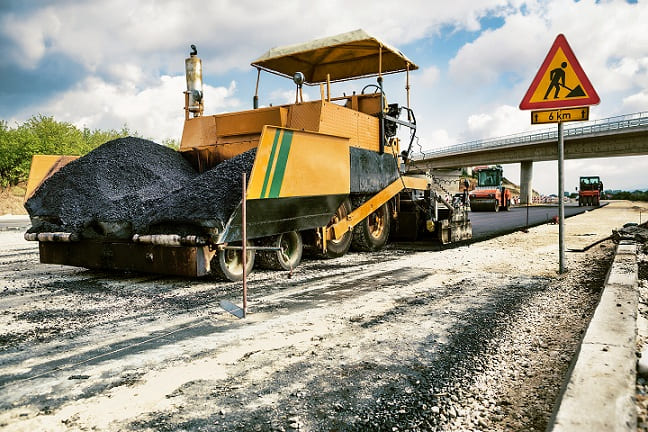Motorways are the main means of ground transportation. Damp weather complicates traffic on dirt roads, limiting their throughput.
Regular technology of ground stabilization with bitumen emulsions is performed at optimal humidity. In this case, part of the water from the emulsion is absorbed by the ground, which makes for uneven distribution of bitumen in the soil.
The necessary condition for uniform distribution of emulsion in the ground and coating each of the mineral particles with a film of bitumen is excessive humidity of the ground. When applying bitumen emulsion, the ground’s humidity must reach the upper limit of ground plasticity.
After drying of the mixture to the optimal humidity and compacting, the resulting material is strong and hydrophobic, resembling sandy asphalt concrete with compressive strength of 50-60 kg/cm2 (after 24 hours of water saturation). Such material is even suitable for the construction of higher class roads.
Bitumen emulsions, as well as other organic binding materials, are used for ground treatment to make it hydrophobic and to stabilize the optimum humidity.
Reinforcement of loose soil with organic binders is similar to shore sand reinforcement with water film. Bitumen also creates a very thin film around the particles when the emulsion separates, which causes the particles to stick together, without disrupting the natural friction forces.
Cohesive ground is a different case, when organic binders are used to partially close the pores in the ground to prevent capillary motion of moisture. Oversaturation of the ground with the binder reduces the strength of the ground, which becomes overly plastic. Cohesive ground also requires the use of the binding properties of the finely dispersed portion (clay). The percentage of binder for cohesive ground is higher than for loose ground, within 7 to 15%.
Cohesive ground require moisturizing to the optimal level before reinforcement. The extra moisture is added with emulsion, which contains about 50% water. With average ratio, with reference to 9% bitumen, extra 9% water is added to the ground, which in combination with the optimal humidity of the ground facilitate the required oversaturation with water for even bitumen distribution.
After mixing by a rotary tiller, the mixture is dried to optimal humidity, profiled and compacted to 0.95-0.96. Preshaping occurs within 1 or 2 days in warm weather.
Binding dosage depends on the presence of organic acid oxides, the chemical properties of the ground surface (increases with the growth of the ratio between valent retained ions and ground dispersion), the quality of mixing, binder type, mineral particle smoothness, porosity (the degree of compaction), climatic and hydrological conditions and other factors. The number of factors precludes theoretical calculation of the dosage, making it variable in a wide range from 2 to 12% of the mineral material weight.
Direct fast breaking emulsions on acidic surfactants are the best match for reinforcement of gravelly ground; they adhere well to any stone material. Particles size must be less than 35-40 mm. Reinforcement is performed by mixing on the road or in a machine. Beside emulsions, gravelly ground can be successfully reinforced by liquid road bitumen combined with cationic surfactants (1.5% concentration).
Sand in road construction is reinforced by direct slow breaking basic emulsions and bitumen pastes. Good results have been achieved by direct medium and slow breaking acidic bitumen emulsions. The dosage as referenced to bitumen varies within 5-9%.



